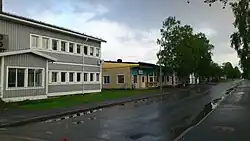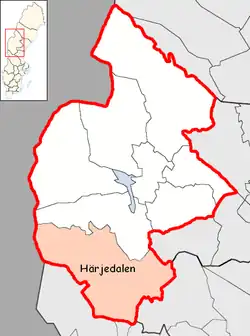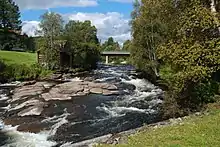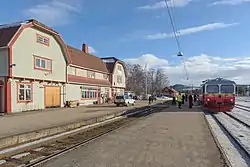Härjedalen Municipality
Härjedalen Municipality (Swedish: Härjedalens kommun, Southern Sami: Herjedaelien tjïelte, Norwegian: Herjedalen kommune) is a municipality in Jämtland County in northern Sweden. Its seat is located in Sveg.
Härjedalen Municipality
Härjedalens kommun | |
|---|---|
 Härjedalen town hall | |
 Coat of arms | |
 | |
| Coordinates: 62°02′N 14°21′E | |
| Country | Sweden |
| County | Jämtland County |
| Seat | Sveg |
| Area | |
| • Total | 11,859.62 km2 (4,579.02 sq mi) |
| • Land | 11,286.1 km2 (4,357.6 sq mi) |
| • Water | 573.52 km2 (221.44 sq mi) |
| Area as of 1 January 2014. | |
| Population (31 December 2021)[2] | |
| • Total | 10,114 |
| • Density | 0.85/km2 (2.2/sq mi) |
| Time zone | UTC+1 (CET) |
| • Summer (DST) | UTC+2 (CEST) |
| ISO 3166 code | SE |
| Province | Härjedalen, Hälsingland and Dalarna |
| Municipal code | 2361 |
| Website | www.herjedalen.se |
The municipality roughly, but not exactly, corresponds with the traditional province Härjedalen.
The municipality was created in 1974 and is one of two in Sweden with the name of a province (Gotland Municipality is the other). It consists of nine original local government entities (as of 1863).
Geography
With a total area of 11,935 square kilometres (4,608 sq mi), it is Sweden's fifth largest. However, it is largely wilderness, and the municipality is sparsely inhabited. For comparison, the municipality covers as much territory as Uppsala County and Stockholm County combined, but those two counties have over 2,000,000 inhabitants.
Localities

There are eight localities (or urban areas) in Härjedalen Municipality:[3]
| # | Locality | Population |
|---|---|---|
| 1 | Sveg | 2,633 |
| 2 | Funäsdalen | 798 |
| 3 | Hede | 763 |
| 4 | Ytterhogdal | 603 |
| 5 | Vemdalen | 547 |
| 6 | Ulvkälla | 445 |
| 7 | Lillhärdal | 365 |
| 8 | Norr-Hede | 293 |
The municipal seat in bold
Riksdag
This table lists the national results since the 1972 Swedish municipality reform. The results of the Sweden Democrats from 1988 to 1998 were not published by the SCB at a municipal level due to the party's small size nationally at the time.
| Year | Turnout | Votes | V | S | MP | C | L | KD | M | SD | ND |
|---|---|---|---|---|---|---|---|---|---|---|---|
| 1973[4] | 85.8 | 8,298 | 5.4 | 55.6 | 0.0 | 25.3 | 6.1 | 1.1 | 5.4 | 0.0 | 0.0 |
| 1976[5] | 87.3 | 8,768 | 4.6 | 56.5 | 0.0 | 26.2 | 5.7 | 1.1 | 5.6 | 0.0 | 0.0 |
| 1979[6] | 86.6 | 8,799 | 5.3 | 58.2 | 0.0 | 21.9 | 5.2 | 1.0 | 8.1 | 0.0 | 0.0 |
| 1982[7] | 87.3 | 8,828 | 5.3 | 59.1 | 1.1 | 18.5 | 3.5 | 1.1 | 11.3 | 0.0 | 0.0 |
| 1985[8] | 85.7 | 8,671 | 4.6 | 58.9 | 1.4 | 15.5 | 7.3 | 0.0 | 12.3 | 0.0 | 0.0 |
| 1988[9] | 81.1 | 8,007 | 6.1 | 56.8 | 4.9 | 14.1 | 7.5 | 1.3 | 9.1 | 0.0 | 0.0 |
| 1991[10] | 83.0 | 8,059 | 4.9 | 51.2 | 2.7 | 12.8 | 5.5 | 3.0 | 12.1 | 0.0 | 6.2 |
| 1994[11] | 82.9 | 8,024 | 7.2 | 58.1 | 5.0 | 10.9 | 3.9 | 1.7 | 11.8 | 0.0 | 0.7 |
| 1998[12] | 77.4 | 7,129 | 17.0 | 46.8 | 3.9 | 8.1 | 2.8 | 6.7 | 12.8 | 0.0 | 0.0 |
| 2002[13] | 74.8 | 6,650 | 12.1 | 50.2 | 3.6 | 11.5 | 6.0 | 4.6 | 9.7 | 0.3 | 0.0 |
| 2006[14] | 77.6 | 6,613 | 8.2 | 45.7 | 2.3 | 12.9 | 4.7 | 3.8 | 17.2 | 2.7 | 0.0 |
| 2010[15] | 80.6 | 6,739 | 6.0 | 44.6 | 3.8 | 9.4 | 3.8 | 2.3 | 22.2 | 7.0 | 0.0 |
| 2014[16] | 82.8 | 6,765 | 5.2 | 42.9 | 3.0 | 10.5 | 2.1 | 1.9 | 17.2 | 15.2 | 0.0 |
Blocs
This lists the relative strength of the socialist and centre-right blocs since 1973, but parties not elected to the Riksdag are inserted as "other", including the Sweden Democrats results from 1988 to 2006, but also the Christian Democrats pre-1991 and the Greens in 1982, 1985 and 1991. The sources are identical to the table above. The coalition or government mandate marked in bold formed the government after the election. New Democracy got elected in 1991 but are still listed as "other" due to the short lifespan of the party. "Elected" is the total number of percentage points from the municipality that went to parties who were elected to the Riksdag.
| Year | Turnout | Votes | Left | Right | SD | Other | Elected |
|---|---|---|---|---|---|---|---|
| 1973 | 85.8 | 8,298 | 61.0 | 36.8 | 0.0 | 2.2 | 97.8 |
| 1976 | 87.3 | 8,768 | 60.1 | 37.5 | 0.0 | 2.4 | 97.6 |
| 1979 | 86.6 | 8,799 | 63.5 | 35.2 | 0.0 | 1.3 | 98.7 |
| 1982 | 87.3 | 8,828 | 64.4 | 33.3 | 0.0 | 2.3 | 97.7 |
| 1985 | 85.7 | 8,671 | 63.5 | 35.1 | 0.0 | 1.4 | 98.6 |
| 1988 | 81.1 | 8,007 | 67.8 | 30.7 | 0.0 | 1.5 | 98.5 |
| 1991 | 83.0 | 8,059 | 56.1 | 33.4 | 0.0 | 10.5 | 95.7 |
| 1994 | 82.9 | 8,024 | 70.3 | 26.6 | 0.0 | 3.1 | 96.9 |
| 1998 | 77.4 | 7,129 | 67.7 | 30.4 | 0.0 | 1.9 | 98.1 |
| 2002 | 74.8 | 6,650 | 65.9 | 31.8 | 0.0 | 2.3 | 97.7 |
| 2006 | 77.6 | 6,613 | 56.2 | 38.6 | 0.0 | 5.2 | 94.8 |
| 2010 | 80.6 | 6,739 | 54.4 | 37.7 | 7.0 | 0.9 | 99.1 |
| 2014 | 82.8 | 6,765 | 51.1 | 31.7 | 15.2 | 2.0 | 98.0 |
Notable natives
- Henning Mankell, author
- Anna Carin Zidek, sportsperson
- Marcus Högström, ice hockey professional
References
- "Statistiska centralbyrån, Kommunarealer den 1 januari 2014" (in Swedish). Statistics Sweden. 2014-01-01. Archived from the original (Microsoft Excel) on 2016-09-27. Retrieved 2014-04-18.
- "Folkmängd i riket, län och kommuner 31 december 2021" (in Swedish). Statistics Sweden. February 22, 2022. Retrieved February 22, 2022.
- Statistics Sweden as of December 31, 2005
- "Riksdagsvalet 1973 (page 168)" (PDF) (in Swedish). SCB. Retrieved 16 August 2017.
- "Riksdagsvalet 1976 (page 162)" (PDF) (in Swedish). SCB. Retrieved 16 August 2017.
- "Riksdagsvalet 1979 (page 187)" (PDF) (in Swedish). SCB. Retrieved 16 August 2017.
- "Riksdagsvalet 1982 (page 188)" (PDF) (in Swedish). SCB. Retrieved 16 August 2017.
- "Riksdagsvalet 1985 (page 189)" (PDF) (in Swedish). SCB. Retrieved 16 August 2017.
- "Riksdagsvalet 1988 (page 169)" (PDF) (in Swedish). SCB. Retrieved 16 August 2017.
- "Riksdagsvalet 1991 (page 31)" (PDF) (in Swedish). SCB. Retrieved 16 August 2017.
- "Riksdagsvalet 1994 (page 45)" (PDF) (in Swedish). SCB. Retrieved 16 August 2017.
- "Riksdagsvalet 1998 (page 42)" (PDF) (in Swedish). SCB. Retrieved 16 August 2017.
- "Valresultat Riksdag Härjedalens kommun 2002" (in Swedish). Valmyndigheten. Retrieved 16 August 2017.
- "Valresultat Riksdag Härjedalens kommun 2006" (in Swedish). Valmyndigheten. Retrieved 16 August 2017.
- "Valresultat Riksdag Härjedalens kommun 2010" (in Swedish). Valmyndigheten. Retrieved 16 August 2017.
- "Valresultat Riksdag Härjedalens kommun 2014" (in Swedish). Valmyndigheten. Retrieved 16 August 2017.
External links
- Härjedalen Municipality Archived 2010-08-11 at the Wayback Machine - Official site
